Cities are becoming smart all over the world, including India, by using technology in various ways. Some define a smart city as a city studded with sensors, which collect information to help manage the city’s assets and resources efficiently. Others say it is the use of information and communication technology (ICT) to transform life and working environments within a region.
But, the Indian government’s Smart Cities Mission website probably says it best: “There is no universally accepted definition of a smart city. It means different things to different people. The conceptualisation of smart city, therefore, varies from city to city and country to country, depending on the level of development, willingness to change and reform, resources and aspirations of the city residents. A smart city would have a different connotation in India than, say, Europe. Even in India, there is no one way of defining a smart city.”
Largely, a smart city infrastructure aims to make life easier and safer for citizens. It provides basic facilities for housing, healthcare, sanitation, food, commutation and communication; reduces pollution; improves sustainability and supply of energy; and fosters business and economic welfare in general. However, what goes into a particular region’s infrastructure and the priority accorded to each element is very region-specific. While a system that helps to accurately display the arrival time of city buses at each bus stop might be smart in a city, a good toilet might be smart in a remote village, and a method of protecting dwellers from wild animals might be the ultimate tool for a tribal settlement in the forest! Merely embedding technology across a city’s functions makes the city intelligent. The city becomes smart only when this technology meets the citizens’ demands and improves their quality of life.
In the journey from mere intelligence to real smartness, technology is just a tool—and at different points of time, various technological products like sensors, cameras and drones, mobile devices and apps, data centres, networks and software appear and disappear from the scene. It is therefore difficult to describe one particular end-to-end solution and say this is the perfect smart city infrastructure. Depending on the local needs, city planners need to pick and stitch together the tools that would work for them.
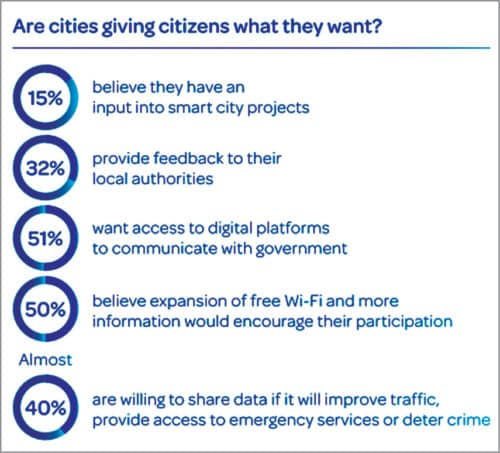
IoT and open data policies at the core
The Internet of Things (IoT) definitely helps make a city smart. Innumerable sensors, mobile devices and video cameras, embedded across the city’s infrastructure and connected over a reliable communications backbone, collect data about everything from traffic to pollution. This data is analysed to extract useful information, which, in turn, is used to implement effective city management systems, ranging from efficient waste collection to traffic signal management. This information enables automation, disaster prevention and recovery, efficient supply and consumption of utilities like water and power, and more.
To be effective, this IoT infrastructure needs to be supported by an apt open data policy to enable universal access and use of the collected data without duplication. Government agencies can also authorise private enterprises to access such databases in order to get the most out of the data in a profitable way. For example, a private company developing a traffic management system can be allowed to access data collected by the existing infrastructure, for a fee, instead of having to redo the whole thing. This not only turns the government’s investment profitable but also makes the infrastructure more streamlined without too much duplication.
A Gartner report adds one more important element to this framework—people. According to Gartner, people themselves will become nodes on the Internet, with both static information and a constantly emitting activity system. Today, there are multiple apps that use crowd-sourced information to make better buying decisions, avoid traffic congestion, explore places and more. It is only fair then that people are considered one of the main resources of a city’s smart infrastructure!
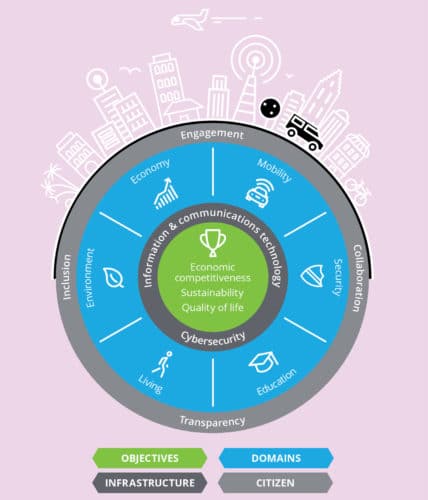
Industry majors like Cisco, IBM, Nokia, Philips, Intel, Schneider Electric, Siemens, Microsoft, Hitachi, Huawei, Ericsson, Toshiba and Oracle have dived headlong into the smart city opportunity. Some companies specialise in a particular area, while others provide end-to-end solutions covering the whole gamut of technologies and systems. There are also innumerable start-ups providing solutions to specific needs of smart cities.
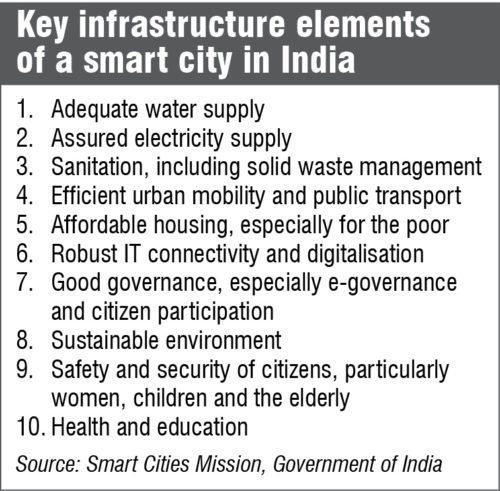
Trip to some of the smart cities
Apart from some of the districts in USA and UK, Aarhus, Amsterdam, Cairo, Lyon, Malaga, Malta, Verona and the Songdo International Business District near Seoul are among regions that have become appreciably smart in many ways in recent years.
Reducing pollution through better traffic management
Las Vegas uses its smart city infrastructure to manage traffic, environmental pollution and other issues. Let’s take the example of its traffic signals: If your car is waiting at a signal and there are no approaching vehicles in sight, the signal turns green rather than making your car wait and exhaust more fumes.Singapore has been implementing different solutions for traffic management since 2014. One among them is a GPS-powered solution that empowers citizens with traffic and roadwork information collected from surveillance cameras installed on roads and taxis. The system also has features like traffic news, travel time calculator, road maps, street directions and parking information. Surveillance cameras alert authorities and vehicle recovery services to road incidents.
Understanding the cause of accidents
On a particular roadway in Jaipur, there were about 4000 accidents annually. The city authorities installed IoT sensors and video cameras to discover the reason. They found that 70 per cent of the accidents happened because drivers went down the road the wrong way. The police used this information to set up sign boards and take other steps to significantly reduce the number of accidents. Sensors in the city also provide information on pollution, availability of parking spots, etc.
Supplementing the city’s energy resources
More than 6000 Viennese citizens have invested in community-funded solar and wind power plants in the last five years. Together, these have produced about 25 million kWh of renewable energy, powering almost 15,000 households. Cities across the world are also using smart grids and meters to save power and augment user-contributed power like solar power. Smart meters help users to study their consumption patterns and avail offers like reduced rates for consumption during off-peak hours. While this helps users to save money, the utility is able to conserve power.

Conserving another precious resource—water
Many regions like Berkeley County and Fountain Valley in USA have installed smart water networks to meet water conservation goals. Beyond just remote meter readings, these systems comprising a FlexNet communication system and residential and commercial meters are used to study and understand usage patterns, detect and prevent leakage, and empower consumers to optimise their usage.
The water utility in Little Egg Harbour, a small town in New Jersey, uses technology in a different way. Residents of this town leave during winter and return only when the weather is warm enough. During these cold months, however, the water freezes and pipes tend to break. Using technology from Sensus, the community’s municipal utilities authority can monitor residents’ homes and quickly respond to problems. This earns them their customers’ trust.
Some cities have also started using solutions like WeatherTRAK to optimise their water usage for landscape irrigation. This system uses an IoT machine-to-machine solution and sensors to assess atmospheric and geologic factors and supply just the needed volumes of water instead of constantly dripping water.
Santander in Spain has deployed IoT tracking with a smartphone app, which enables residents to view real-time data on water quality and consumption, track trends over time and receive service alerts. The IoT tracking system provides information about water demand, supply, pressure, quality and other environmental factors, enabling efficient water supply and conservation and sustainable management.
Getting ready for smart waste collection
The Spanish city of Granada is in the process of connecting 14,000 waste bins across the city using sensors. The data collected will be used to identify the bins that need to be emptied, and to optimise pick-up truck routes accordingly. The IoT City Digital Platform in Denmark also includes intelligent waste monitoring using sensors fitted by SmartBin. The Smart City Framework developed by the Sunshine Coast Council in Australia also includes waste management using Enevo’s smart fill sensors.
Making sewers smarter too
Cincinnati, USA, has a smart sewer that reduces the overflow of sewage into water bodies. This is a task that normally consumes millions of dollars of the taxpayers’ money! The smart sewer system responds to peaks and troughs in demand from various areas of the city. It enables the utility to store sewage flows in huge interceptor facilities located in various parts of the sewer system, with smart sensors used to detect and monitor flow levels and manage the gates and valves to direct the flow to locations with sufficient space. Within a few weeks, the system developed by Ayyeka helped the city to avoid 1.4 million gallons of sewer overflows.
Improving safety through reliable lighting
Street lighting is important to ensure safety. At the same time, the usage has to be optimised to save power. To balance these requirements, many cities are now installing IoT-connected and energy-efficient light-emitting diodes (LEDs) for street lighting. These lights can be centrally operated and managed using intelligent software, powered using alternative energy supplies, or even made smart enough to detect human movement and switch off when there is nobody on the street!
Amsterdam in the Netherlands is working with Philips to install connected LED lights that can save a city up to $13 billion a year. Santander is also rolling out intelligent LED lights that dim or brighten depending on the time of day and the presence of people. These can save around $1.5 million a year.
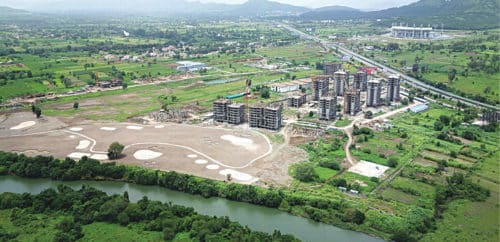
Smart products used by smart cities across the world
All over the world, interesting solutions are sprouting to cater to the needs of smart cities. Let’s look at some of the promising ones.
To navigate in a smart city, citizens and visitors need the Internet. But, what if you cannot afford mobile data (which is steeper on roaming)? To solve this problem, a Malaysian company called Simplify has developed an app that lets users sell excess bandwidth. Using this app, you can turn your Android smartphone into a secure hotspot, set a price to share it and sell to others. You can receive payments immediately through PayPal. This ability to buy spare data from others around them has proven to be very convenient, especially for tourists.
Non-stop communications is one of the highlights of a smart city. Any solution that can take connectivity to remote areas or augment the existing communication networks in busy areas is always worth including in a smart city framework. AT&T has developed a drone that provides LTE coverage to customers. It can be used to provide connectivity when the existing networks and services are likely to get overloaded or disrupted.
AT&T’s Cell on Wings (fondly called Flying COW) is basically a cell site on a drone, designed to beam LTE coverage from the sky to customers on the ground during disasters or big events. The drone carries a small cell and antennae and is connected to the ground by a thin tether. The tether provides a highly secure data connection via fibre and supplies power to the Flying COW, allowing non-stop flying.
Shanghai saw a 30 per cent drop in crime rates, thanks to its smart security solutions. To get there, a smart city needs proactive surveillance, not merely security cameras that let authorities to analyse the scene after a crime takes place. Deep Glint is a solution that uses 3D imaging to monitor large crowds and the way people on the scene behave. When the smart cameras spot a fight, unusual behaviour or doubtable characters, these instantly alert the concerned authorities.
ShotSpotter is another such safety solution. Although gunfire might be something we see only in movies, there are some areas where it is an everyday threat. However, the atmosphere in such areas is shrouded with fear and people hide as soon as gunshot is heard rather than report it immediately. Solutions like ShotSpotter or a network of sound sensors embedded in street lights can be used to report the incident immediately to concerned officials.
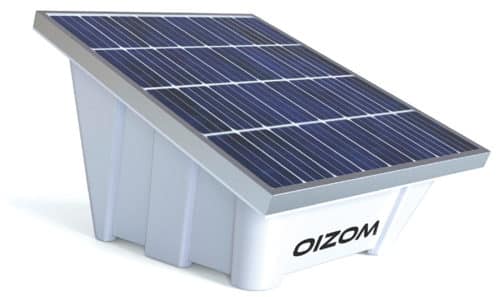
Bigbelly offers a smart waste collection and recycling system that has been used in more than 50 countries across the globe. It is not merely an IoT-connected bin but also has a built-in solar-powered waste compacting system that enables the bin to store up to five times the amount of waste as a traditional bin of the same size. When it needs to be emptied, the bin alerts the appropriate city department, helping timely waste clearance and proper optimisation of pick-up truck schedules.
Another off-beat initiative in waste management is Zerocycle—a solution that collects and analyses garbage and recycling data to determine recycling rates for all neighbourhoods in a city. This information can be used to prepare customised waste reports for each neighbourhood, which can be circulated among residents. Although it sounds like a simple application, it has been found to be useful in creating awareness about recycling.
Citymapper is a solution that helps travellers to move around comfortably in a new place. It combines information about the locality’s public transport and provides multi-modal transport options to help users get to their chosen destination easily.
Searching for an available parking lot not only kills your precious time but also causes more pollution as you keep circling the neighbourhood! ParkWhiz app helps you find a parking spot in public or private parking lots. It even lets you reserve a paid slot using your credit card.
Cities need actionable information on sources of pollution in order to take corrective and preventive measures. EverImpact is a climate monitoring app that discovers the origins of greenhouse gas emissions in a city. It measures and monetises the city’s carbon dioxide emission by mapping ground-level sensor data with satellite locations. City officials get a real-time map of emissions at street and building level.
A successful city needs to be inclusive, providing a comfortable environment for those with disabilities. GPS-enabled mobile app BlindSquare is a successful digital service developed from open data in Helsinki. It helps visually-impaired people navigate through the city by describing the environment, announcing points of interest and street intersections, guiding them as they go along.
Awesome Indian products for smart cities
The Indian government’s 100 smart cities dream has also spurred a lot of activity in India. The government has made it clear that this dream can be achieved only through public-private synergy. Although there is not much information about what the first 20 chosen cities are doing with their funding, we do hear of random smart developments every day—whether it is a partnership between ISRO and Indian Railways to improve safety, a single dashboard for India’s power sector, a system that will speed up tray clearance at the Delhi airport, SMS notifications about delayed trains, increase in digital transactions, tools to speed up Aadhaar verification, or an upcoming drone policy. The start-up economy is also buzzing with new ideas and ventures.
GetMyParking is a Delhi-based start-up that gathers data from parking lots, helping citizens spot and reserve parking. IdeaForge provides solutions for drone-based safety and surveillance, while Flamencotech works on technology for smart buildings and Oizom Instruments develops IoT-based environment monitoring solutions. WeDoSky also works with drones but it customises the intelligence gained from the aerial images for varied purposes like security, irrigation, power lines installation and prediction of an area’s solar power potential. Smart Cities Wheel is another Indian start-up that helps urban planners to design more efficient cities using artificial intelligence.
Esyasoft Technologies offers software and analytics for smart grids, while Maven Systems specialises in automated lighting and smart meters. There are some start-ups with even bigger ideas. One among them is Quenext, which aims to consolidate and analyse data from innumerable systems ranging from weather to power, to help utilities optimise their supply and reduce losses. LoudCell develops IoT-based sensors, remote hardware and cloud-based middleware, which are coupled with an intuitive dashboard to provide customers with analytics and intelligence to understand and reduce their power consumption.
A low-cost smart irrigation controller from FlyBird Farm Innovations helps farmers to irrigate their crops precisely, depending on weather, soil conditions and crop requirements. One more interesting solution for this sector comes from TartanSense, which aims to use unmanned aerial vehicles and machine learning to bring actionable intelligence to the agricultural sector.
Zippr is a Telangana-based company that creates eight-digit alphanumeric codes to replace traditional door numbers. These unique IDs are mapped to precise locations overlaid on a digital map. This fundamentally transforms how locations are referenced, shared and navigated. Zippr won the IBM Smart Camp for Smart City 2016, and is working with the Telangana government to implement this smart address system in Hyderabad.
Taxi services like Ola and Uber are playing their part in building smart cities by providing innovative ride options, including sharing and shuttle services. These bring down the cost of rides, improve commute facilities and reduce pollution through car-pooling.
Programmes such as the AIM Smart City Accelerator provide mentorship, guidance and planning support for start-ups and other agencies working towards the smart city dream!
Opportunity is knocking at our doors through Smart City
McKinsey Research projects the smart city industry to be a $400 billion market by 2020, with 600 cities worldwide, which are together expected to generate 60 per cent of the world’s GDP by 2025.
A Forbes article by Mohit Kochar of KPIT Technologies explains how smart cities are India’s next technology opportunity to lead the world. He states rapid urbanisation, excellent ecosystem, manpower and tech prowess, the third largest start-up base in the world and a reputed brand image in information technology as reasons why we are well poised to capitalise this opportunity.
Clearly, there is no dearth of technologies required for smart cities in India too. However, we need to focus on proper planning and infrastructure development. The investment also needs to be thoughtful and transparent. It is estimated that the first 100 smart cities in India will require an annual investment of ` 350 billion over the next 20 years! This can simply not be achieved without private investments and public-private partnerships. There must also be excellent collaboration between central, state and local authorities.
Private and government agencies must also understand that such cities cannot be built without the participation of people. This is being reiterated time and again by experts in the field. People come in at the very beginning of the process—because solutions for a smart city have to be built around what people need and not merely what other cities have done! The residents of a city have to be involved all through the processes of conceptualisation, planning, development and implementation.
The smart city infrastructure must also be easy for people to use. For example, we need to remember that connectivity is poor, so implementers have to think about how to work around it. Literacy levels being low, you cannot expect everybody to type in passwords or fill in online forms. Methods like facial recognition or biometrics have to be used to authorise individuals and validate data. In such and many other ways, government officials have to ensure that people can transition smoothly to this connected world—because, whether it is in 2025 or later, cities are inevitably going to get smarter!







